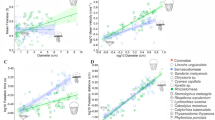Summary
The pressure difference between the cardinal sinus and the pericardium, and the transmural ventricular diastolic pressure at rest and during swimming in the leopard shark, Triakis semifasciata, was measured to characterize the mechanism of cardiac filling in chronically-instrumented fish and to evaluate cardiac responses to swimming. Echo-Doppler and radiographic imaging were also used to fully describe the cardiac cycle. Swimming induces an increase in preload as manifested by a large increment of cardinal sinus pressure (0.26/0.20 [systolic/diastolic] to 0.49/0.32 kPa) which always exceeds pericardial pressure. Increases in both mean ventricular diastolic transmural pressure (0.30–0.77 kPa) and cardinal sinus pressure during swimming suggest increased cardiac filling by vis a tergo as the mechanism for augmenting cardiac output. In contrast to mammals, the fluid-filled pericardial space of elasmobranchs is considerably larger and the pericardium itself does not move in concert with the heart throughout the cardiac cycle. Also, modest increases in heart rate drastically curtail the duration of diastole, which becomes much less than that of systole, a phenomenon not found in mammals. In the absence of tachycardia (<40 bpm), ventricular filling is characterized by a period of early rapid filling, and a late period of filling owing to atrial systole, separated by a period of diastasis. Ventricular filling in elasmobranchs is thus biphasic and is not solely dependent on atrial systole. Atrial diastole is characterized by three filling periods associated with atrial relaxation, ventricular ejection, and sinus venosus contraction. The estimated ventricular ejection fraction of Triakis (80%) exceeds that of the mammalian left ventricle.
Similar content being viewed by others
References
Abel DC, Graham JB, Lowell WR, Shabetai R (1986) Elasmobranch pericardial function. 1. Pericardial pressures are not always negative. Fish Physiol Biochem 1:75–83
Andresen JH, Ishimatsu A, Johansen K, Glass ML (1987) An angiocardiographic analysis of the central circulation in the teleost, Channa argus. Acta Zool (Stochn) 68:165–171
Butler PJ, Metcalfe JD Ginley SA (1986) Plasma catecholamines in the lesser spotted dogfish and rainbow trout at rest and during different levels of exercise. J Exp Biol 123:409–421
Dodge HT (1971) Determination of left ventricular volume and mass. Radio Clin N Am 9:459–467
Guntheroth WG, Morgan BC, Mullins GL (1967) Effect of respiration on venous return and stroke volume in cardiac tamponade. Circ Res 20:381–390
Hanson D (1967) Cardiovascular dynamics and aspects of gas exchange in Chondrichthyes, Ph.D. Dissertation. University of Washington, Seattle
Johansen K (1965a) Cardiovascular dynamics in fishes, amphibians, and reptiles. Ann NY Acad Sci 127:414–442
Johansen K (1965b) Dynamics of venous return in elasmobranch fishes. Hval Skr 48:94–100
Johansen K (1971) Comparative physiology: Gas exchange and circulation in fishes. Ann Rev Physiol 33:569–612
Johansen K, Gesser H (1987) Fish cardiology: structural, haemodynamic, electromechanical and metabolic aspects. In: Nilsson S, Holmgren S (eds) Fish physiology: Recents advances. Croom-Helm, London Canberra, pp 71–85
Lai NC, Graham JB, Lowell WR, Shabetai R (1989) Elevated pericardial pressure and cardiac output in the leopard shark, Triakis semifasciata, during exercise: the role of the pericardioperitoneal canal. J Exp Biol 147:263–277
Miyazaki S, Guth BD, Miura T, Indolfi C, Schulz R, Ross J Jr (1990) Changes of left ventricular diastolic function in exercising dog without and with ischemia. Circulation 81:1058–1070
Prange HD (1976) Energetics of swimming of a sea turtle. J Exp Biol 64:1–12
Randall DJ (1968) The functional morphology of the heart in fishes. Am Zool 39:185–192
Santer RM (1985) Morphology and innervation of the fish heart. In: Beck F, Hild W, Ortmann R, Pauly JE, Schiebler TH (eds) Advances in anatomy, embryology, and cell biology. Springer, Berlin Heidelberg New York, Vol 89
Santer RM, Greer Walker M (1980) Morphological studies on the ventricle of teleost and elasmobranch hearts. J Zool (Lond) 190:259–272
Satchell GH (1970) A functional appraisal of the fish heart. Fed Proc 29:1120–1123
Satchell GH (1971) Circulation in fishes. Cambridge University Press, London
Schoenlien K, Willem V (1894) Observations sur la circulation du sang chez quelques poissons. Bull Sci Fr Belg 26:442–468
Shabetai R (1981) The pericardium. Grune and Stratton, New York
Shabetai R, Abel DC, Graham JB, Bhargava V, Keyes RS, Witztum K (1985) Function of the pericardium and pericardioperitoneal canal in elasmobranch fishes. Am J Physiol 248:H198-H207
Smith HW (1929) The composition of the body fluids of elasmobranchs. J Biol Chem 81:407–419
Sudak FN (1965a) Intrapericardial and intercardiac pressures and the events of the cardiac cycle in Mustelus canis (Mitchill). Comp Biochem Physiol 14:689–705
Sudak FN (1965) Some factors contributing to the development of subatmospheric pressure in the heart chambers and pericardial cavity of Mustelus canis (Mitchill). Comp Biochem Physiol 15:199–215
Thaulow E, Guth BD, Heusch G, Gilpin E, Schulz R, Kroeger K, Ross J Jr (1989) Characteristics of regional myocardial stunning after exercise in dogs with chronic coronary stenosis. Am J Physiol 257:H113-H119
Tota B (1983) Vascular and metabolic zonation in the ventricular myocardium of mammals and fishes. Comp Biochem Physiol 76A:423–437
Author information
Authors and Affiliations
Rights and permissions
About this article
Cite this article
Chin Lai, N., Shabetai, R., Graham, J.B. et al. Cardiac function of the leopard shark, Triakis semifasciata . J Comp Physiol B 160, 259–268 (1990). https://doi.org/10.1007/BF00302591
Accepted:
Issue Date:
DOI: https://doi.org/10.1007/BF00302591




